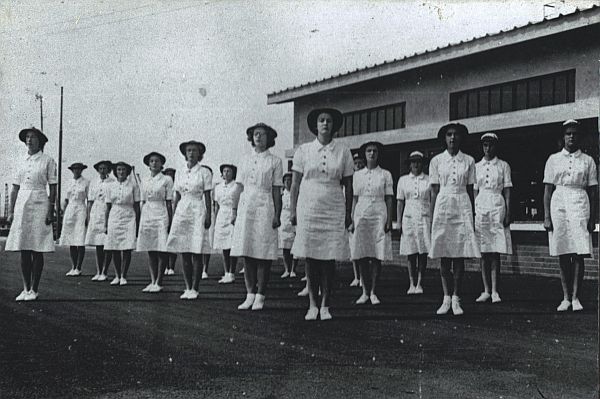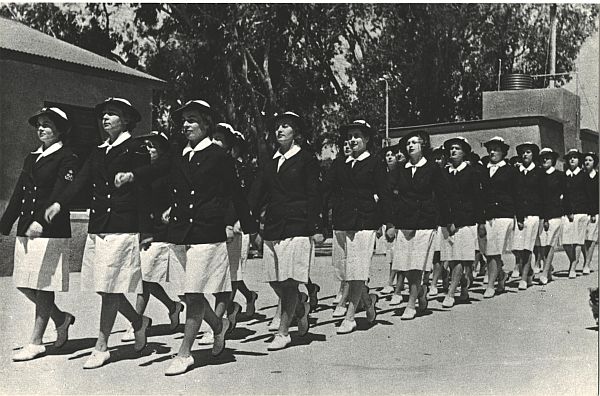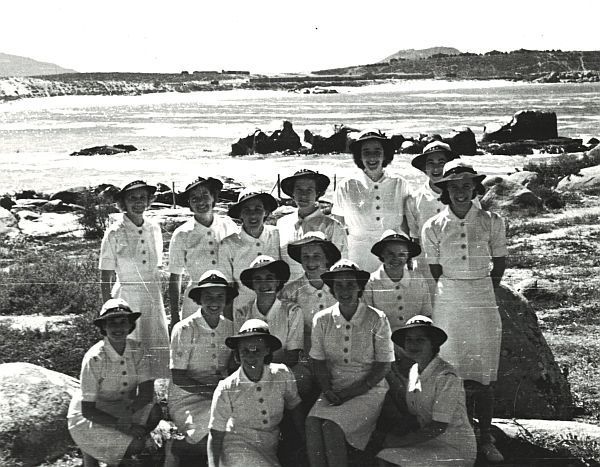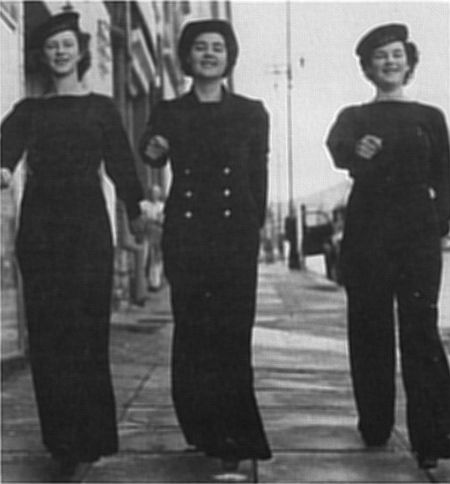

 The South African
The South African
The formation of the SA Women's Auxiliary Naval Service (SAWANS) was sanctioned in August 1943, after some initial objections from the Chief of the General Staff.
During the first two or three years of World War 2, forty-seven Army women clerks and telephonists had been attached to the South African Naval Force, and from this small nucleus the first Naval Women's unit was formed with a Naval uniform of their own.

SWANS training at SAS Unitie Cape Town
Inauguration
This only happened after strong addition to these girls from the Women's
representations from Commodore J. Dalgleish had overcome the opposition. In
Auxiliary Army Service (WAAS), many
more were required for posts hitherto
filled by men, the latter being sorely
needed to man the South African minesweepers
and antisubmarine vessels.
Recruiting was carried out by Lt Miss
B.E. Skyrme, WAAS, who now became a
2nd Officer, and Senior Officer,
SAWANS. The new unit was formally
inaugurated on 9 October, 1943, with a
parade and march through Cape Town in
the new uniforms. For the next two years
2nd Officer Skyrme was the only officer
in the SAWANS and many senior ratings
carried out responsibilities which in any
other arm of the women's services would
only have been entrusted to commissioned
officers. However, as the
establishment only allowed for one
officer, these petty officers had to be
content to remain in their ranks.
Similarities
Nevertheless, there was a wonderful esprit de corps among the ratings. They soon became known by the acronym 'Swan' which was incorporated into the designation used for female ratings, as in Leading Swan, Chief Petty Officer Swan, and so on; in the same manner as members of the Women's Royal Naval Service were addressed as 'Wrens'.

SWANS on Robben Island
There were other similarities between these two services - the uniform was almost identical, even down to the bell- bottom trousers and sea jerseys for the watch-keepers. The same discipline was applied, as well as Naval procedures, traditions and customs, squad drill, boat- pulling and rifle shooting. There were even shooting competitions between Wrens stationed in Cape Town and Swans.
A further strong link between the two services was CPO B.M. Scannell, WRNS, who was the first woman regulating petty officer on Robben Island, where she was seconded to help the Technical Branch Swans shake down, and to train Swan Regulators in Quarters Management.
Technical 'Firsts'
With the formation of the Anti- Submarine branches Swans were trained in technical duties - Asdic Operators on Robben Island and Controlled Mines Watch-keepers at Saldanha Bay. Eventually Swans served on shore defence Asdic stations at Umhlanga, Port Elizabeth and East London, as well as on Robben Island. All these ports had their complement of Clerical and Communications Swans, and in certain cases Swans were trained in special duties as Wiremen, Attack Teacher Instructors, and as Higher Submarine Defence operators who undertook the repair of ships' asdic equipment.

SWANS at Saldanha during World War II
One Swan worked in the Naval Architect's Office as a draughts-woman and another was a Base Transport Driver in Durban. The Swans in these two Technical Branches were the first women in the world to be used in this capacity, and they released many [sic] men for seagoing duties.
Comradeship
Altogether 316 girls served in the Swans and they were found to be efficient and enthusiastic in a previously masculine preserve. After some initial hesitation, the men serving beside the Swans came to appreciate their new colleagues, and a good comradeship soon built up, with the men doing all they could to initiate the newcomers into the vagaries of the service. And despite the only-to-be-expected leg-pulling and practical jokes, the Swans greatly appreciated the help given by their male opposite numbers.

SWANS stepping it out in Cape Town
(Photo: Courtesy of the Cape Times)
After the War
At the war's end in 1945, Miss Skyrme married and left the unit. She was succeeded by 2nd Officer Mrs Stella Hattingh. There was only one other Swan officer - 3rd Officer Joan Ellis who was commissioned for special duties after the war had ended, and worked with other branches of the South African forces in Pretoria.
After VE Day, Technical Branch Swans were posted to various clerical, communications and quarters duties until they were gradually demobilised and, over the years, dispersed across Southern Africa, and as far away as Egypt, Kenya, England, Australia, Canada, Spain, the USA and even Brazil.
Reunion and Reminiscences
In 1972 a successful Reunion was held in Simon's Town. In 1986 a history of the Swans was published. Written by Miss M.P.H. Laver, a former Swan, it serves as a comprehensive, permanent record of the unit. Many of the illustrations in the book are by ex-Swans of World War 2, supplemented by individual reminiscences of former Swans.
Funds were raised for publication of the history by the issue of a Commemorative First Day Cover (No 5 in the SA Navy Series). In this effort, the Swans were assisted by the SA Navy, the Post Office, their own families, and by members of the Association of Wrens (a wonderful continuation of the spirit of co-operation that existed during the war).
Other Activities
Swans joined in many activities during and after the war, helping as demonstrators at Victory Fairs in Pretoria and Cape Town and taking part in an elaborate stage performance, 'Fortress Cavalcade'. They also participated in the concert party and amateur dramatics at the base - HMSAS Bonaventure, and a physical training team competition at the Old Drill Hall. Several non-watchkeeping Swans, in their off-duty time, assisted as waitresses at the Mayor's Garden Services Club.
After demobilisation many ex-Swans carried the experience gained in the Navy over into civilian life, becoming involved in community and social work. A surprising number became commissioners in the Girl Guide movement, or were active in the Red Cross and St John [Ambulance]. Several became professional social or health workers, and not a few obtained university degrees after demobilisation, including at least one doctorate.
Through the Years ...
All benefited from their service days. Many friendships begun then have endured through the years. It is almost like membership of an exclusive club - only 316 members, after all!
The passing of 50 years has brought its toll in deaths and failing health, but I am sure all ex-Swans remember their wartime service with nostalgia and gratitude for a wonderful experience.
An Association of ex-Swans of World War 2 has been formed under the Chairmanship of Mrs Isobel Bester, whose interesting newsletters keep us in touch with our former 'shipmates'.
50th Anniversary Reunion
A reunion to mark the 50th Anniversary of the establishment of the South African Women's Auxiliary Naval Service of World War II was held from 9-11 October 1993 year. In the Cape Town area, there is a luncheon at SAS Unitie on the 9th, a service at St George's, Dockyard Simon's Town on the 10th and a 'trip down memory lane' visit to Robben Island on the 11th.
Former World War II Swans from all over Southern Africa and abroad are attending the anniversary. Amongst many special events a lesson will be read at the church service on the 10th by Mrs Brenda Walker (formerly 2nd Officer B.E. Skyrme, the first officer in the 'Swans').
Acknowledgements
Thank you to Mrs L Edwards for permission to use this article which first appeared in Navy News Vol XII October 1993.
Thank you to the South African Naval Museum for the use of the photographs unless otherwise attributed.
Return to Journal Index OR Society's Home page
South African Military History Society / scribe@samilitaryhistory.org